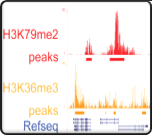BroadPeak

BroadPeak broad peak calling algorithm for diffuse ChIP-seq datasets.
Downloads
- Manual - Instructions on running BroadPeak and input file preparations
Scripts
- BroadPeak.tar.gz - BroadPeak scripts
Sample Data
- The sorted bedGraph files of histone modification ChIP-seq data from Barski et al. Cell 2007.
1. H3K27me3.bed
2. H3K36me3.bed
3. H3K36me3_region_for_estimation.bed
- The simulated dataset for broad peak calling test.
1. simulated_bedGraph.bed
2. simulated_read_BED_file.bed
Readme
A. Preparation:
In order to run BroadPeak, you need to:
1) Download the compressed folder BroadPeak.tar.gz;
2) Decompress the folder. There are three files within the created folder: a) BroadPeak, b) unsupervised_estimation.R and c) Manual.
3) Make sure these files are always kept in the same folder.
4) Make sure R program is already installed on your computer.
5) Check the shebang line of the BroadPeak file and correct it by the path of env of your computer.
6) Add the directory of the folder BroadPeak into the PATH.
B. Running BroadPeak:
The command line for BroadPeak is:
$ BroadPeak -i [input bedGraph file] -m [identifier for output files] -b [bin size] -g
[genome size] -t [type of parameter estimation] -r [BED file for supervised parameter estimation]
-R [the directory of R]
The detailed explanations of the parameters can be found in Section D.
One example of running BroadPeak is:
$ BroadPeak -i ./H3K36me3.bed -m H3K36me3 -t unsupervised
This command takes the sorted bedGraph format file of H3K36me3 ChIP-seq data as the input and use the unsupervised method for parameter estimation. A folder named as "H3K36me3" will be created (specified by -m) and all outputs will be in this folder. Other parameters use the default values.
C. File Format:
The input file of the sorted ChIP-seq read-mapping profile in the genome needs to be in bedGraph format. The four tab-delimited columns are chromosome, start, stop and tag count.
Note:
1) a BED format file of reads will not work. You need to first scan the genomic read-mapping to create the bedGraph file of ChIP-seq profiles (i.e. tag counts for each small genomic bin).
2) The size of each record (the bin) should be equal (e.g. 200bp, if you scan the genome by dividing it to 200bp non-overlapping bins).
3) The locations should be already sorted for each chromosome.
If you want to do supervised parameter estimation (i.e. -t supervised), you also need to provide (using -r) a BED format file of the genomic regions that are believed to be enriched with broad peaks (e.g. some highly expressed genes for broad-peak calling of H3K36me3).
The output file will be a BED format file of the genomic locations of broad peaks. In the output folder, there will be a folder named as *_broad_peak_*, the final BED output file is located in this folder.
D. Parameters:
-i: The bedGraph format input file (with the correct path) of the sorted ChIP-seq read-mapping profile in the genome.
-m: The identifier used to name the output folder, e.g. use H3K27me3 to name the output folder
for broad-peak calling of H3K27me3.
-b: The size of bin, default value 200 (bp). It should be consistent with the bedGraph format
input file (i.e. equal to the size of the bins in the input file).
-g: The size of the genome under consideration, default value 3107677273 (bp) for the human genome (hg18).
-t: The type of parameter estimation. It can be either "supervised" or "unsupervised".
-r: If -t is set as "supervised", a BED format file (with the correct path) of genomic regions
used for supervised parameter estimation need to be given.
-R: If R program is not in the PATH, you can use -R to specify the directory of R program.
-h,-help: Display brief explanations of parameters.